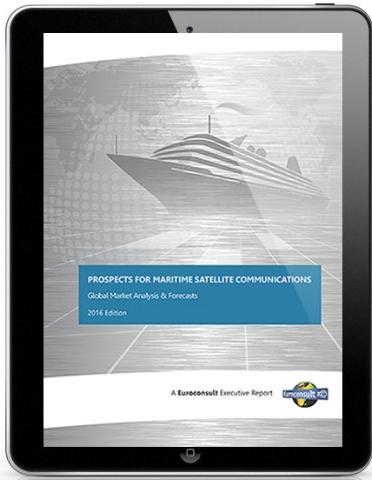
While the slowdown in the oil industry has negatively affected the maritime sector in 2016 because of some decommissioning, there is still a demand for maritime sat communications, and it is growing due to increasing operational communications needs.
According to Euroconsult'snewly-published report, Prospects for Maritime Satellite Communications, in 2015 the global maritime satellite communications market reached close to 338,000 terminals, $953 million in revenue at the satellite operator level and $1.7 billion in revenue at the service provider level. The value of the maritime satcom market will continue to grow over the next decade, with a CAGR of 5 percent in terminals and revenue over the 10-year period. Ever-increasing data communications needs and the massive launch of new generation High Throughput Satellite (HTS) systems are expected to drive growth.

The collapse in oil prices and the global oversupply in the merchant sector, which particularly affected bulkers, have continued to negatively impact the maritime sector overall in 2016, resulting in a number of vessels decommissioning. However, demand for maritime satellite communications continued to grow, driven by increasing operational communications needs, as opposed to crew communications a few years ago. Even though crew communications still represent the vast majority of a ship's consumption, vessels' operators are increasingly interested in big data-driven applications that improve operational efficiency. As a result, the number of VSAT terminals grew by 9 percent in 2015 to reach more than 16,000 commercial active terminals at year-end. A total of 8.5 Gbps of C-, Ku- and Ka-band capacity was used for maritime VSAT business, compared to less than 2 Gbps in 2010.
"2016 was an important milestone for maritime satellite communications. It marked the entry into service of HTS satellites with a major maritime focus, with the entry into commercial operation of Inmarsat Global Xpress and Telenor's Thor 7 satellite, in addition to the launch of the first two Epic satellites," said Capucine Fargier, Consultant at Euroconsult and editor of the report. "A number of additional HTS satellites will be launched in the coming years, with maritime satellite supply expected to reach ~680 Gbps by 2020. This will result in a significant decrease in capacity prices which, along with innovations at the antenna level with the entry into service of flat-panel antennas in 2017, will drive demand for more bandwidth-hungry applications such as big data analytics and video streaming applications."
Regarding MSS services, competition and migration to VSATs will continue on large vessels. However, the development of smaller and cheaper MSS broadband terminals covering basic communications needs of small vessels will open up a new market for MSS broadband. This low-ARPU yet high-volume vertical market is expected to be the main growth driver for MSS services. Consolidation in the sector is expected to continue and will benefit service providers with higher purchasing power and economies of scale. We will see consolidation among both maritime players (as demonstrated by the recent acquisition of CapRock by SpeedCast) and other mobility vertical (such as GEE's acquisition of EMC).
http://www.euroconsult-ec.com/shop/mobile-communications/89-maritime-satcom.html

